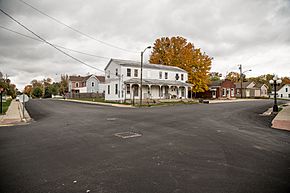Moores Hill, Indiana facts for kids
Quick facts for kids
Moores Hill, Indiana
|
|
|---|---|
 |
|

Location of Moores Hill in Dearborn County, Indiana.
|
|
| Country | United States |
| State | Indiana |
| County | Dearborn |
| Township | Sparta |
| Area | |
| • Total | 0.43 sq mi (1.11 km2) |
| • Land | 0.43 sq mi (1.11 km2) |
| • Water | 0.00 sq mi (0.00 km2) |
| Elevation | 994 ft (303 m) |
| Population
(2020)
|
|
| • Total | 675 |
| • Density | 1,569.77/sq mi (606.07/km2) |
| Time zone | UTC-5 (Eastern (EST)) |
| • Summer (DST) | UTC-4 (EDT) |
| ZIP code |
47032
|
| Area code(s) | 812 |
| FIPS code | 18-50958 |
| GNIS feature ID | 2396779 |
Moores Hill is a town in Sparta Township, Dearborn County, Indiana, United States. The population was 597 at the 2010 census.
History
Platted in 1839 by Adam Moore and Andrew Stevens, it originally contained nine lots adjacent to Moore's gristmill. The community was originally known as Moores Mill, but postal authorities misspelled it Moores Hill, and the name stuck.
Many early settlers in the town were Methodist families from Delaware and the shore of Maryland. The first mercantile business was established by Samuel Herron.
Moores Hill and its citizens are the subjects of the 1941 volume Pop. 359, a book of poems self-published by Indianapolis Star columnist Carl Wilson under the pseudonym Tramp Starr.
Carnegie Hall of Moores Hill College and Moores Hill United Methodist Church are listed on the National Register of Historic Places.
Landmarks
Carnegie Hall was built in 1908 as part of Moores Hill College (now the University of Evansville). It has been used as an academic building, and has also housed an elementary and high school. It is now a museum.
Geography
According to the 2010 census, Moores Hill has a total area of 0.54 square miles (1.40 km2), all land.
Climate
The climate in this area is characterized by hot, humid summers and generally mild to cool winters. According to the Köppen Climate Classification system, Moores Hill has a humid subtropical climate, abbreviated "Cfa" on climate maps.
Demographics
| Historical population | |||
|---|---|---|---|
| Census | Pop. | %± | |
| 1850 | 206 | — | |
| 1870 | 617 | — | |
| 1880 | 333 | −46.0% | |
| 1890 | 469 | 40.8% | |
| 1900 | 338 | −27.9% | |
| 1910 | 424 | 25.4% | |
| 1920 | 285 | −32.8% | |
| 1930 | 349 | 22.5% | |
| 1940 | 359 | 2.9% | |
| 1950 | 445 | 24.0% | |
| 1960 | 476 | 7.0% | |
| 1970 | 616 | 29.4% | |
| 1980 | 566 | −8.1% | |
| 1990 | 649 | 14.7% | |
| 2000 | 635 | −2.2% | |
| 2010 | 597 | −6.0% | |
| 2020 | 675 | 13.1% | |
| U.S. Decennial Census | |||
2010 census
As of the census of 2010, there were 597 people, 223 households, and 155 families living in the town. The population density was 1,105.6 inhabitants per square mile (426.9/km2). There were 252 housing units at an average density of 466.7 per square mile (180.2/km2). The racial makeup of the town was 97.8% White, 0.2% African American, 0.2% Asian, 0.7% from other races, and 1.2% from two or more races. Hispanic or Latino of any race were 0.3% of the population.
There were 223 households, of which 36.8% had children under the age of 18 living with them, 48.4% were married couples living together, 12.6% had a female householder with no husband present, 8.5% had a male householder with no wife present, and 30.5% were non-families. 26.0% of all households were made up of individuals, and 8.5% had someone living alone who was 65 years of age or older. The average household size was 2.68 and the average family size was 3.22.
The median age in the town was 37.5 years. 28.5% of residents were under the age of 18; 7.6% were between the ages of 18 and 24; 27.2% were from 25 to 44; 26.7% were from 45 to 64; and 10.1% were 65 years of age or older. The gender makeup of the town was 47.4% male and 52.6% female.
Notable people
- Walt Justis, baseball player
- E. J. Pennington, automotive pioneer
- Janet Rumsey, baseball player
See also
 In Spanish: Moores Hill para niños
In Spanish: Moores Hill para niños

